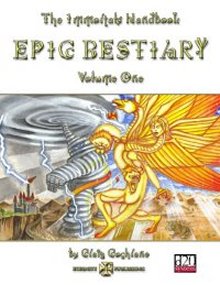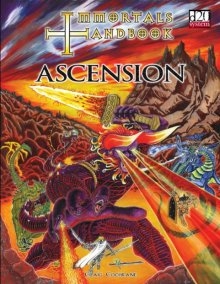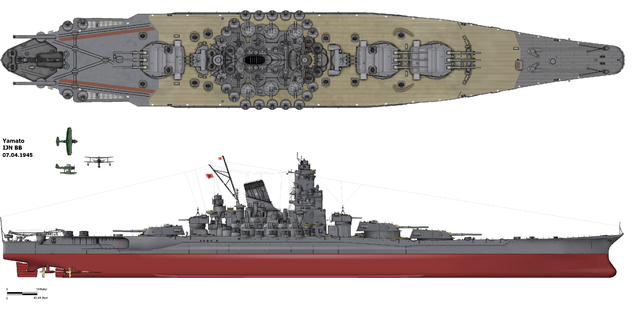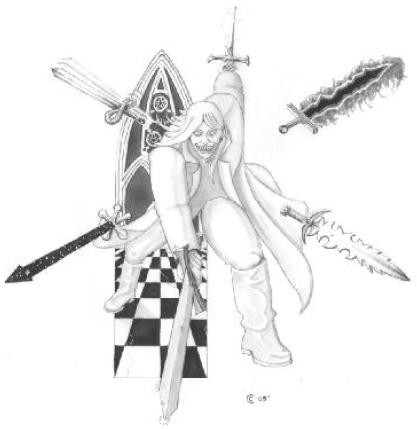Immortals Handbook by NGDBSS
Introduction
Original SA post Scientific Notation Ahoy!: Let's Read the Immortals Handbook

The Immortals Handbook (not to be confused with Immortal: the Invisible War) was a project designed to facilitate play at epic levels in D&D 3E. It's not been the first, but it's one of the two best known (Dicefreaks* being the other) because of its draw as That Book with the Huge Numbers. Hugely ambitious (it was originally intended to be a seven-book collection), it nonetheless fell short of its expectations for two reasons.
First, epic levels in 3E blow so horribly that no amount of nails, timbers, and bracing can hold them up. To correct their flaws requires rebuilding the system from its very foundations (which 4E did relatively well). Second, the project only ended up as two books, the Epic Beastiery and Ascencion; the remaining books fell by the wayside when 4E was released. Craig Cochrane's been working on something for 4E but nothing's been published yet; at least there he's building off a sounder system.
Still, you can't fault the man for trying, and in the sake of fairness I'll be reviewing both books. The Bestiery doesn't actually have as many rules concerning play, so Ascension will be the meat of this. I'll assume people are generally familiar with D&D 3E; if you aren't you can brush up on it here .
Alright, so what's with the nickname?
Recall how I compared the Immortals Handbook (referred to as IH in the future) to the Dicefreaks project? Even Dicefreaks characters are limited to two-digit levels and ability scores; IH not only has no upper limit but is intended to allow for play at far higher power.
quote:
Low Epic: ECL 21-40 (suitable for prophets and hero-deities)
Mid-epic: ECL 41-80 (suitable for quasi-deities and demi-deities)
High Epic: ECL 81-160 (suitable for lesser and intermediate deities)
Low Cosmic: ECL 161-320 (suitable for greater deities and elder ones)
Mid-cosmic: ECL 321-640 (suitable for old ones and first ones)
High Cosmic: ECL 641+ (suitable for demiurges and time lords )

...
Joking aside, next time I'll be getting into the Bestiery's mechanics intended for non-god PCs and NPCs.
*Strictly speaking Dicefreaks is a message board/community that happens to be constantly refining an epic-levels project. For the sake of brevity I'm conflating the two.
More Charts Than a Laplace Transform
Original SA postwdarkk posted:
I can't imagine how they were expecting the game system to work at all past level 30 or so (comedy option: it stopped working well before then so who cares).
But to answer your actual question, the hope seems to have been that if everything could be reduced to comparable numbers (instead of wild trump cards like, oh, Vancian casting), then you can work out various forms of baselines and scaling to get a reasonable game. While this assumption doesn't work for 3E (see above), it does work for 4E. I'm actually kinda interested to see a finished product for that; even if it has problems it still has a proper set of mechanics to start from.
Scientific Notation Ahoy!: Let's Read the Immortals Handbook
Part 1: More Charts Than a Laplace Transform
Let's start with page 2, shall we? It's nice to see the monsters ranked in order of CR (Challenge Rating, a measure of a monster's power as an enemy threat) to enable a rough guess on what to throw your players. As a helpful bonus ECLs (Effective Character Level, a measure of a monster's power as a party member) are given, so we have creatures like these in the list: (slash and colon added for clarity)
quote:
Diamond Guardian: 6 / 10
 )
)
quote:
Quintessence Elemental, Greater: 40 / 60
quote:
Mercury Colossus: 89 / 160
quote:
Neutronium Golem: 9721 / 17,497

We'll be taking a good look at some of those monsters, especially that last one.
Anyway! Page 3 lists several new epic feats, and the very first is Automatic Metamagic Capacity. It's, well, a bit on the long side. See, not only does it have its own complicated mechanics but it also alters existing mechanics.
quote:
When you select this feat you gain one free level of metamagic per round, which you may spontaneously apply to any spell you can cast.
quote:
This feat is suggested as the replacement for the following epic feats: Automatic Quicken Spell; Automatic Silent Spell; Automatic Still Spell and Improved Spell Capacity.
The various Automatic Quicken/ Silent/Still spell feats are unbalanced. Improved Spell Capacity becomes more pedantic the higher in power you become, while in addition progressively alienating more and more lower level spells.
...
In any case, gutting ISC is a wash. While CC does have a point that if you have higher-level slots you start to forget about the lower-level ones, removing the feat (and others, as we'll see) ends up forcing you to pitch all your feat slots on crap like this instead. It exchanges one (kinda abusable) metamagic system for another (rubbish) one.
Next is Epic Potency, which is the damage-based equivalent of Epic Prowess. It's just as terrible.
 Killer Instinct removes the whole "study your target for three rounds" bit in the Assassin's Death Attack, so it might be nice if you're not dealing with things immune to sneak attacks. Oh wait, epic.
Killer Instinct removes the whole "study your target for three rounds" bit in the Assassin's Death Attack, so it might be nice if you're not dealing with things immune to sneak attacks. Oh wait, epic.
 There are also Armor Mastery feats, which remove penalties for wearing the armor...except that at epic levels the problems with armor lie more in restrictions that aren't actually penalties (maximum Dex bonus to AC and numerous AC bonuses that require no armor). I've made arena characters that got around just fine without armor; the stuff was actually a hindrance.
There are also Armor Mastery feats, which remove penalties for wearing the armor...except that at epic levels the problems with armor lie more in restrictions that aren't actually penalties (maximum Dex bonus to AC and numerous AC bonuses that require no armor). I've made arena characters that got around just fine without armor; the stuff was actually a hindrance.
quote:
THREE-WEAPON FIGHTING

This is the first of a tree of feats like TWF. The idea within fluff is that you're constantly juggling weapons around, silly as that sounds. All in all it suffers from the same massive problems as TWF, namely: being extremely reliant on bonus damage outside of Power Attack, being reliant on expensive gear, and representing a massive sunk cost in feats. That last one is actually compounded by the fact that you need Perfect TWF to even start the tree, so you're paying the whole damn cost again.
The last feat here, Metamagic Freedom, is like AMC in that it is this book's other needless metamagic retcon. See, it allows you to double up on a metamagic effect as high as you like, assuming you have the capacity to actually pull it off. Kinda meh when you think about it, considering that good metamagic is generally expensive. Though of course all of those nuts with Arcane Thesis are gasping for joy. (Arcane Thesis-based builds generally find ways to stack lots of powerful metamagic effects on a spell without paying for most of it. Several pay no net cost at all, so with MF you could try tossing around infinite damage. Oops!) The feat also allows you to multi-quicken spells to cast more than one per round in a poorly-explained way:
quote:
A spell can only be quickened more than once a round with the free levels of metamagic granted by Automatic Metamagic Capacity. In any given round, you may cast one spell that is not quickened, one spell that is prepared as quickened, and any number of spells quickened spells , each using 4 free levels of metamagic from your Automatic Metamagic Capacity quota for that round.
quote:
In the wake of this feat the following feats become redundant: Improved Heighten Spell; Intensify Spell and Multispell. It is also suggested that you remove the Improved Metamagic feat altogether.
quote:
Improved Heighten Spell should be unnecessary if you already have Heighten Spell.
quote:
Intensify Spell is simply a combination of two applications of empower spell and one application of maximise spell.
quote:
Multispell is simply two (or more) applications of quicken spell.
Alright, that post ended up a lot longer than I thought it would be, but I'll be able to post more later today.
Next Time: The Eighth Dimension and Macro-Diminutive Wyrmlings
The Eighth Dimension and Macro-Diminutive Wyrmlings
Original SA post Scientific Notation Ahoy!: Let's Read the Immortals HandbookPart 2: The Eighth Dimension and Macro-Diminutive Wyrmlings
Pages 4-7 detail another thing that CC allowed to scale indefinitely: creature size. 3E originally limited things to nine sizes, from Fine (half-a-foot tall or smaller) to Colossal (sixteen or more times the scale of humans), for the sake of simplicity - going beyond Colossal (treated as a 30' square in combat) just made for unnecessarily large dimensions when a customized wall would be better for all intents and purposes. Even Colossal+, a "size" one step above Colossal, didn't actually increase a creature's physical size (it instead slightly increased its range and base damage). But IH felt this was a bug rather than a feature of the system, so now you too can understand how small "Macro-Diminutive" really is. (Hint: Small is the exact opposite.)
Let me back up for a moment and explain how size works in 3E. "Medium" is the default size and encompasses the scale of creatures like humans, elves, and orcs. "Small" is one step lower and meant for halfings and gnomes, while "Large" is one step higher and meant for stuff like trolls. In total, there are four sizes lower than Medium and four sizes higher (plus Colossal+), and moving between size categories (SC) incurs certain modifiers. For each SC above Medium, certain values changed - some things got penalties, some things got bonuses. Similarly, if you went in the opposite direction you got the opposite effect. Here's the short list, along with scaling:
-
Armor Class (AC): Exponential penalty
-
Attack modifiers: Exponential penalty
-
Hide modifier: Arithmetic penalty
-
Grapple modifier: Arithmetic bonus
-
Space (in-game dimensions): Chart-based (sort-of exponential) multiplier
-
Reach: Chart-based (sort-of exponential) multiplier
-
Carrying capacity: Exponential multiplier
- Base weapon damage: Exponential multiplier
(Notably, speed does not scale based on size, but is instead an ad-hoc thing.)
Given that the degree from which you could deviate from Medium was severely limited, even the exponential scaling on some of these didn't make much difference in actual gameplay. (It's possible to further invoke multipliers on the last two for certain wild purposes*, but it's a significant investment of resources that often as not turns "I kill my opponent" into "I overkill my opponent".) So what happens when we remove the boundaries?
For a start, "Colossal+" was renamed to "Titanic" and now carries its own modifiers, so it gets to share in the increasing madness of exponentiation. Second, space and reach had their chart-based scaling removed; instead they scale by truly exponential means now. (It's technically based instead on the creature's dimensions, but the ranges for those scale exponentially with SCs.) Third, speed is no longer an ad-hoc value, but instead some goofy (possibly exponential) chart-based thing now. And fourth, Strength scales slightly better when increasing monster size to keep up with that whole square-cube law.
So how's this exponential scaling come to do something? Well, now that there are no limits on how large something can be we need new names for things. Anything larger than Titanic has a prefix category (Macro, Mega, Giga, etc.) in addition to one of the standard size adjectives, so the progression goes Titanic -> Macro-Fine -> Macro-Diminutive, and so on. Once you reach Titanic within a given prefix category, you then advance to Fine within the next one.
At this point we can puzzle out what "Macro-Diminutive" actually means, being a full seven SCs bigger than Medium. So that wyrmling I was talking about (yes, there are wyrmlings in this book of that size) is actually about as big in both size and weight as, say, this humble little dinghy:

It also gets a significant -64 to AC and attack modifiers, but on the same chart that notes the scaling modifiers it recommends minimum Hit Dice (HD) for creatures of various sizes, and in our case 256 HD should be sufficient to offset that in Base Attack Bonus (BAB) alone. (BAB scaling is proportional to HD, between 1/2x and 1x.) It has a speed of 480' (as a quadruped, bipeds are slower), so its movement relative to its size is actually rather slow. (At least it can fly at 1440'.) Supposing charitably that it's a 600' beastie, its space is the same size and its reach is 400'. All in all, when you get to sizes this large you're basically doing the YuGiOh thing of adding extra zeroes for no real benefit.
In addition to actual SCs scaling like crazy, you can also pick up Virtual Size Categories (VSCs) for added
 with numbers. IH points out that increased Strength denotes increased muscle (and thus increased muscle mass) but fails to understand that we're playing fantasy elfgames; we don't need to have some codified meaning for "huge muscles" when making comparisons to Conan are sufficient. Instead it unintentionally wanders into the territory of troll logic:
with numbers. IH points out that increased Strength denotes increased muscle (and thus increased muscle mass) but fails to understand that we're playing fantasy elfgames; we don't need to have some codified meaning for "huge muscles" when making comparisons to Conan are sufficient. Instead it unintentionally wanders into the territory of troll logic:
-
Linear increases in Strength bring about exponential increases in carrying capacity. (For every +10 Strength it's x4 carrying capacity.)
-
Linear increases in carrying capacity are due to a linear increase in muscle/bone mass. (Thus linear increases in Strength denote exponential increases in muscle/bone mass.)
-
Because the musculoskeletal system is over half one's body weight, it can be assumed that beyond a certain point weight basically scales at the same rate as muscle/bone mass.
-
What else in the game brings about increases in Strength, weight, and carrying capacity? Size categories!

quote:
eg. A human with an inherent strength of 40 (+30 above average) would weigh approximately 1400 pounds , fully eight times heavier than a typical human male (approximately 175 pounds).
I briefly noted above that VSCs allow you to wield heavier weapons. How heavy? Page 94 describes how to make equipment with some starmetal called orichalcum. (To be fair this is an actual mythological metal.) Depending on the proportion of orichalcum in an object, it's heavier and more expensive, but also more protective or damaging. On the high end, a Medium-sized greatsword made entirely of this stuff deals base damage as if seven size categories larger (16d8), but has a price tag of 26 million gp (!) and weighs as as the Saturn V rocket with its launcher platform. It's possible to alloy this stuff for less effect and less weight, but even at the lowest end where it actually means something (down to a 2 -18 fraction that's not standard steel or what-have-you) it's still relatively heavy (x8) and hilariously expensive for its effect (five or more figures for everything but shields, with a 1.5x multiplier on its effect).
Really, if I had a character with enough Strength to use a pure orichalcum weapon, I'd go with Hulking Hurler and Bloodstorm Blade to simply throw the stuff for far more damage. (That greatsword that deals 16d8 damage? Throw an equivalent mass of orichalcum or whatever and you can instead deal more like 80Kd6 per hit.)
In any case, pages 8-9 end the whole discussion of large numbers for their own sake and instead unironically explore a variant on the "turtles all the way down" joke, namely: where do creatures more powerful than gods live? Basically, our standard three dimensions are part of the seven that compose reality, and beyond that are three more that compose an infinite number of realities. The highest (tenth) of these is the Akashic Records (another nod to real-world mythology), which has this interesting property in Ascension:
quote:
The Akashic Records are analogous to the roleplaying game system you use. The great library representing all the books and gaming supplements on your shelves.

There's also Byss, a nothingness "below" our standard three (void-based creatures are folded pieces of this), and the Nth dimensions, a space between the rest. But all of these are basically "so-and-so resides here, and this is its name" - very banal stuff. I'd prefer the Astral Sea to this.
Next Time: Abominations and Angels
*Hulking Hurler shenanigans and unarmed strike damage.
Abominations & Angels
Original SA post Scientific Notation Ahoy!: Let's Read the Immortals HandbookPart 3: Abominations and Angels
To refresh some memories, "abominations" in the D&D sense were introduced in the Epic Level Handbook (ELH) as Divine Rank (DvR) 0 godspawn. Story goes that they're unwanted/illegitimate offspring, and thus end up being horrifying perversions of the divine portfolios (or other characteristics) of their parents. Not a bad plot hook, all things considered.
IH lists five new abominations:
-
Amilictli (Air)
-
Anakim (Strength)
-
Gibborim (Gluttony)
-
Odium (Plants)
- Sadim (Greed)
So far as monsters go...this one might have been more interesting if it were the climax encounter to a nonepic campaign. Not only can it fly, but it's constantly surrounded by storms that batter and toss its opponents; this might have been interesting as a sort of puzzle boss in which the object is less damage than figuring out how to impart that damage. As it stands, however, at level 46 most adventuring parties should have access to many, many spell buffs and magic items.
Magic items? See, wealth-by-level scaling in 3E gets wonky very easily; the designers seem to have come up with numbers in a by-guess-and-by-god manner and so the actual values you see are neither exponential nor polynomial, but somewhere in the middle. I've analyzed it and it's faster than cubic scaling, which has worrisome consequences when you consider that magic item bonuses only scale quadratically. Even with the silly x10 multiplier on "epic" bonus numbers you can still have the problem of runaway values. (At least 4E came out with an easy-to-follow scale that was fully exponential for both wealth-by-level and bonuses.)
Anyway, following the current progression, epic characters at around level 46 should have upwards of (as a lower limit) 22 million gold. Even if you just spend that on bonuses, you have a lot of bonuses available. Even a straight +24 enhancement bonus to some good ability score is just a quarter of this (5.76 million), leaving lots of room for other stuff - like immunities and bonuses to AC/saving throws. All of this makes most of the attacks of the amilictli a bit impotent. Sure, it attacks at +111 and its most potent save DCs are at 73, but I've made characters in arenas at level 25 who might weather (pardon the pun) those attacks. At level 46 a party (even one that's not optimized to the hilt) has enough resources to take that stuff on without much issue. (Its own AC is laughable at 46.)
Honestly, the only problems a party might have with this "monster" are twofold:
-
Rolling a natural one on some saving throw. This is one of the things that high-level play can boil down to; even with bonuses/penalties pushing far beyond the range of the RNG, there's always the possibility of auto-hitting or auto-missing on an attack or a saving throw. Thankfully, most of the effects of this can be bypassed either with immunities or abilities that allow for rerolls. (A golf bag of luck blades helps.)
- It can cast blasphemy. At will. Caster level (CL) 89. Unlike many instant-kill attacks, blasphemy and the other words of alignment (holy word, dictum, word of chaos) have no save whatsoever to avoid their nastiest effects. (There is a save, but only to avoid being banished if you're not on your native plane.) Instead, their effect is predicated entirely on caster level - so if you can't block it (with spell resistance/SR or a protection against sonic attacks) you're just screwed.
The rest of the abominations are mostly more of the same; abilities that would have been interesting at lower levels but that now are rather moot due to improper scaling on saves/AC or due to immunities. Several points of interest include:
-
One of the anakim's abilities deals ability drain, even to creatures immune to it. This isn't the first instance I've seen of stuff trumping immunities but it's always goofy to see the arms race in action.
-
Being an embodiment of gluttony, the gibborim has a pocket dimension inside itself in which all sorts of weird things live. There's even a random encounter chart; it's actually more interesting than fighting the beast.
-
Suggested tactics for these monsters always include Greater Dispel Magic, full attacks, or both. Problem is that their attack bonuses often can't keep up well with PC ACs (with the exception of the anakim) and that Greater Dispel Magic's effect is capped low enough that it's incapable of actually doing anything.
-
With the exception of the amilictli, none of these abominations can fly. This is a tactic that's been in the game since level 5, so PCs have had no excuse to avoid it since level 15 (or so). Oops!

- I actually missed this two posts ago, but it looks like Epic Spellcasting was not removed or altered at all . (Several monsters in IH have the feat.) Which means that silly bonuses and counters just get easier.

Let's face it, the art in this book can at times be amusingly poor. And yet we have to keep in mind that IH is very much the work of Craig Cochrane and no one else. Yes, even the art. So while I would much rather see something with more skill, credit must be given at least to the effort CC put in to all facets of the project.
Proceeding right along, because the akalich is not a monster so much as a template we begin with an example character, Nimrod the archwizard.
quote:
Nimrod was once a powerful wizard-king who challenged the supremacy of the gods themselves. He possessed an almighty artifact that even the gods feared, and as such they dared not openly attack him. Nimrod planned to build a great city that would reach into the very heavens, a platform from which he would launch the assault on the gods and become their ruler. As his power waxed the people began to worship Nimrod and cast down the old gods.
However with mighty epic magics the gods cursed their former worshippers with a spell that prevented them from being able to understand one another. After which the construction of the city and the worship of Nimrod halted. With his plans in tatters Nimrods shaky mental health collapsed. Disorientated and debilitated, the gods chose to strike en masse. Initially catching Nimrod off guard and almost defeating him. But Nimrods power was immense and lesser deities crumbled beneath his wrath. But the gods sacrifice was not in vain and Nimrod was blasted from the mortal plane into a realm of nothingness, from whence it was hoped he would never return.
Nimrod's powers center partly around being an epic wizard (even with the set-your-feats-on-fire, or SYFOF, system, he still has time to pick up a lot of slots and Epic Spellcasting) and partly around his template. He also has a better-than-you artifact (it grants bonuses based on an opponent's own numerical values), but that's, well, plot-based; all we can really analyze is his template. Interestingly, you don't have to be a demilich or even a lich to become an akalich. (It's often assumed, however.) Instead, most of the benefits overlap:
-
Akaliches are incorporeal undead, so while they have larger hit dice and can fly this can't compensate for the fact that those traits (undead and incorporeal) stopped being benefits and instead became liabilities a while ago.
-
Like liches and demiliches, they have several "useful" spell-like abilities (SLAs) and highly-damaging/instant-kill abilities. "Useful" because the SLAs are likely overshadowed by actual spellcasting, and most (not all, see below) of the damage/instant-kill abilities are nullified by death ward.
-
Though both are still save-or-die effects (and thus easy to block with high save bonuses and a pile of rerolls), an akalich can still either put an opponent in stasis or (like a demilich) yank out its soul.
-
Sufficiently powerful souls are what an akalich needs to power its rejuvenation and overshadow abilities. Overshadow just deals damage equal to the akalich's hit points (which are kinda shit), while rejuvenation brings it back from destruction on the spot. Interestingly enough, the akalich template doesn't actually state that the phylactery and soul gems work the same way as with the templates that it draws from, so if you're just concocting an akalich from scratch (like Nimrod) it's actually very easy to bring the beast down. (Really, this should have just stated that you had to be a demilich first.)
- Akaliches get a bunch of other bonuses/resistances/immunities (like their predecessors, but more), but what's interesting is that it retains 3.0-style Immunity to Magic. More on this below.

After this comes the akishra, basically a giant flying viperfish. If you see one of these you may want to be worried, as they're actually the severed tentacles of a cogent (a more powerful Far Realms creature also in the book). Ultimately, with just a bit more something I'd really like these. They can drain Wisdom on sight (immunities), charm nearby creatures (immunities), and attack anything they can see by means of space-bending. Hell, creatures they swallow via grappling (...immunities) are teleported thousands of miles away. Unfortunately, that's most of what they can do. Sure, there's a breath weapon, but at level 40 you're probably immune to electricty damage or easily capable of making a DC 58 save. Their bite is about as scary as a squirrel at this point (there is Devastating Critical but...immunities), and their damage reduction (DR) of 25/epic-lawful-mindless is a joke even if you can't bypass it.
Wow, this post was far longer than I thought. Guess I'll get to the angels next time. Plus this Mary Sue.

Next Time: Abominations and Angels, Redux